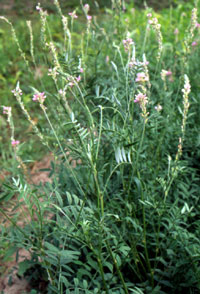





 Sainfoin is a fast-spreading
plant with attractive flowers,
a good cover choice.
Sainfoin is a fast-spreading
plant with attractive flowers,
a good cover choice.
Each time we plant flowers and vegetables, we deplete the garden soil of vital nutrients and organic matter. Without replenishment, the soil loses its power to feed your plants. To feed your soil, consider cover crops, fast-spreading plants grown for the sole purpose of improving your soil. Cover crops, also called green manures, prevent erosion, control weeds, are inexpensive, and are easy to grow.
Download our cover crops chart for helpful information on what to plant, when to plant, and other characteristics.
Downloading requires Adobe Acrobat software.
Cover crops chart
Download Adobe Acrobat
continue reading below1. Availability -- Green manures and cover crops work their magic during the winter, when compost is scarce.
2. Daily vitamins -- Cover crops slowly release nutrients and produce organic matter in your soil.
3. Good bugs -- Cover crops attract good bugs that keep your flowers pollinated and bad bugs at bay.
4. Weed killers -- Typically fast-growing, cover crops smother any weed that rears its ugly head.
5. Nutrient retainers -- A bare, off-season garden loses nutrients through leaching. The roots of cover crops act as holding tanks for these vital nutrients, keeping them in place until your flowers and vegetables can use them.
6. Soil retainers -- Neither wind, nor rain, nor snow will take away your soil. Weather conditions disturb the soil and cause erosion. The foliage from cover crops works on the surface to keep the dirt in place.
7. Nutrient pumps -- Just like oil rigs, the long-rooted varieties of cover crops draw nutrients from deep within the soil to ground level, where your flowers and vegetables can access them.
8. Nitrogen heaven -- Legume varieties of cover crops are nitrogen lovers, sucking nitrogen from the air and storing it in nodules in the roots. Once tilled into the soil, the nitrogen is released and ready to feed your plants.
9. Loose soil -- The roots of cover crops serve as automatic tillers, breaking up compacted soil. Loose soil invites earthworms to set up residence and holds moisture better, making your garden more resistant to drought.
10. All natural -- Cover crops are all-natural. Per square foot of garden, they're also generally less expensive than chemical fertilizers.
Copyright © www.100flowers.win Botanic Garden All Rights Reserved